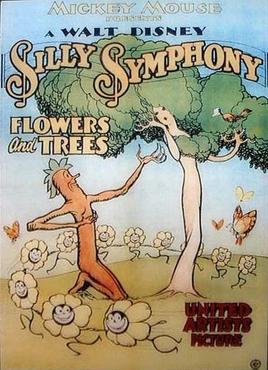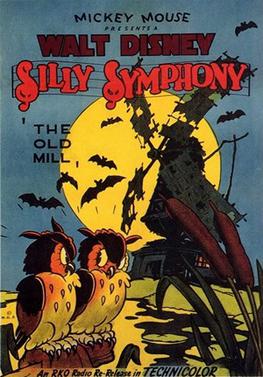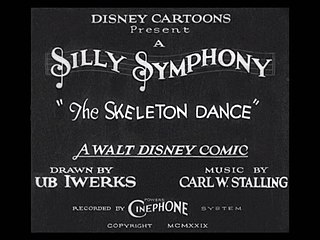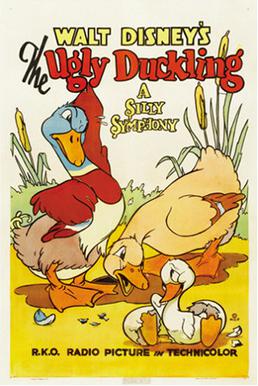Related Research Articles

The Wise Little Hen is a 1934 Walt Disney's Silly Symphony cartoon, based on the fable The Little Red Hen. The cartoon features the debut of Donald Duck, dancing to "The Sailor's Hornpipe". Donald and his friend Peter Pig try to avoid work by faking stomach aches until Mrs. Hen teaches them the value of labor.
Silly Symphony is an American animated series of 75 musical short films produced by Walt Disney Productions from 1929 to 1939. As the series name implies, the Silly Symphonies were originally intended as whimsical accompaniments to pieces of music. As such, the films usually did not feature continuing characters, unlike the Mickey Mouse shorts produced by Disney at the same time. The series is notable for its innovation with Technicolor and the multiplane motion picture camera, as well as its introduction of the character Donald Duck making his first appearance in the Silly Symphony cartoon The Wise Little Hen in 1934. Seven shorts won the Academy Award for Best Animated Short Film.

Flowers and Trees is a Silly Symphonies cartoon produced by Walt Disney, directed by Burt Gillett, and released to theatres by United Artists on July 30, 1932. It was the first commercially released film to be produced in the full-color three-strip Technicolor process after several years of two-color Technicolor films. The film was a commercial and critical success, winning the first Academy Award for Best Cartoon Short Subject.

The Old Mill is a Silly Symphonies cartoon produced by Walt Disney Productions, directed by Wilfred Jackson, scored by Leigh Harline, and released theatrically to theatres by RKO Radio Pictures on November 5, 1937. The film depicts the natural community of animals populating an old abandoned windmill in the country, and how they deal with a severe summer thunderstorm that nearly destroys their habitat. It incorporates the song "One Day When We Were Young" from Johann Strauss II's operetta The Gypsy Baron.

The Skeleton Dance is a 1929 Silly Symphony animated short subject produced and directed by Walt Disney and animated by Ub Iwerks. In the film, four human skeletons dance and make music around a spooky graveyard—a modern film example of medieval European "danse macabre" imagery. It is the first entry in the Silly Symphony series. In 1993, to coincide with the opening of Mickey's Toontown in Disneyland, a shortened cover of the cartoon's music was arranged to be featured in the land's background ambiance. The short's copyright was renewed in 1957, and as a published work from 1929 it will enter the US public domain on January 1, 2025.
Music Land is a Silly Symphony animated Disney short released in 1935.

The Ugly Duckling is an animated short film by Walt Disney, based on the 1843 fairy tale "The Ugly Duckling" by Hans Christian Andersen. The film was directed by Jack Cutting and Clyde Geronimi, and released in theaters on April 7, 1939. Music was composed by Albert Hay Malotte, who was uncredited for the film. The animated short was first distributed by RKO Radio Pictures, and was shown with Love Affair.

The Big Bad Wolf is an animated short released on April 13, 1934, by United Artists, produced by Walt Disney and directed by Burt Gillett as part of the Silly Symphony series. Acting partly as a sequel to the wildly successful adaptation of The Three Little Pigs of the previous year, this film also acts as an adaptation of the fairy-tale Little Red Riding Hood, with the Big Bad Wolf from 1933's Three Little Pigs acting as the adversary to Little Red Riding Hood and her grandmother.

The Tortoise and the Hare is an American animated short film part of the Silly Symphony series, released on January 5, 1935, by United Artists, produced by Walt Disney and directed by Wilfred Jackson. Based on an Aesop's fable of the same name, it won the 1934 Oscar for Best Short Subject: Cartoons. This cartoon is also believed to be one of the inspirations for Bugs Bunny by Warner Bros., who first appeared in 1940.
Egyptian Melodies is a 1931 Silly Symphonies animated short subject produced by Walt Disney and directed by Wilfred Jackson.
The Ugly Duckling is an animated black-and-white cartoon released by Walt Disney in 1931 as part of the Silly Symphonies series. This cartoon was later remade into a color version released in 1939, which follows the original Andersen story much more faithfully. This gives The Ugly Duckling the unique distinction of being the only Silly Symphony to be made twice. This film was then sold to reach about 4,000 dollars per month at the most profit, because it slowly climbed up the scale of growth.
The Grasshopper and the Ants is a 1934 American animated short film produced by Walt Disney Productions and released by United Artists. Part of the Silly Symphonies series, the film is an adaptation of The Ant and the Grasshopper, one of Aesop's Fables. It was directed by Wilfred Jackson and stars Pinto Colvig as the voice of the grasshopper Hop.

Wynken, Blynken & Nod is a 1938 Silly Symphonies cartoon, adapted from Eugene Field's poem of the same name. Like other Symphonies at the time, it utilized the multiplane camera. It was directed by Graham Heid, produced by Walt Disney Productions, and distributed by RKO Radio Pictures. The three children bore similarities to Michael Darling in the 1953 Disney feature film, Peter Pan.
The Flying Mouse is a Silly Symphonies cartoon produced by Walt Disney, directed by David Hand, and released to theatres by United Artists on July 14, 1934. The use of color here was rather innovative as it is set during the course of a single day.

The Robber Kitten is a 1935 Walt Disney Silly Symphonies cartoon, directed by David Hand.
Birds of a Feather is a Silly Symphonies animated Disney short film. It was released on February 10, 1931, by Columbia Pictures.
Mother Goose Melodies is a 1931 Silly Symphonies animated film, directed by Burt Gillett. Two years later it was semi remade in Technicolor as Old King Cole.
The China Plate is a 1931 Silly Symphonies animated film.

Father Noah's Ark is a Walt Disney Silly Symphonies animated film. It is based on the story of Noah's Ark. The short's musical score is an adaptation of the first dance in Ludwig van Beethoven's 12 Contredanses. The cartoon was released on April 8, 1933.

Farmyard Symphony is a 1938 Silly Symphonies animated short film. It can be seen as a precursor to Fantasia due to using various pieces of classical music in one short. The film was directed by Jack Cutting and produced by Walt Disney.
References
- 1 2 Merritt, Russell; Kaufman, J. B. (2016). Walt Disney's Silly Symphonies: A Companion to the Classic Cartoon Series (2nd ed.). Glendale, CA: Disney Editions. pp. 92–93. ISBN 978-1-4847-5132-9.
- ↑ "Talking Shorts". Variety : 17. July 14, 1931. Retrieved February 23, 2020.
- ↑ "Sound Shorts". The Film Daily : 11. July 19, 1931. Retrieved February 23, 2020.
- ↑ "Silly Symphonies: The Historic Musical Animated Classics DVD Review". DVD Dizzy. Retrieved February 20, 2021.